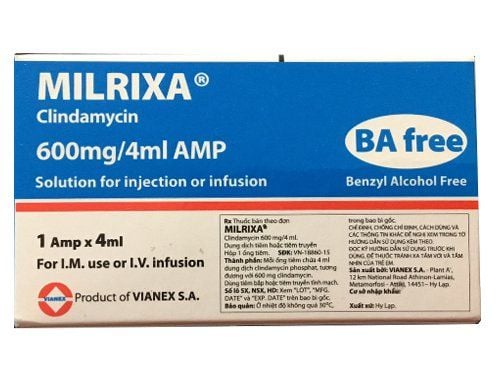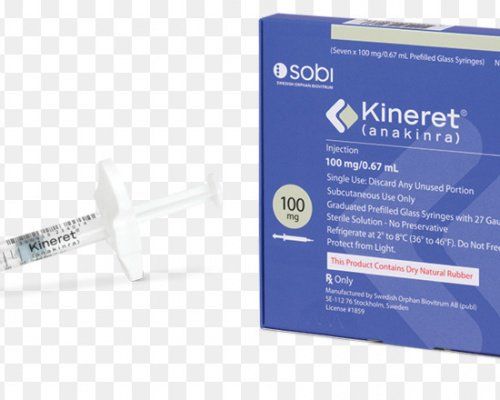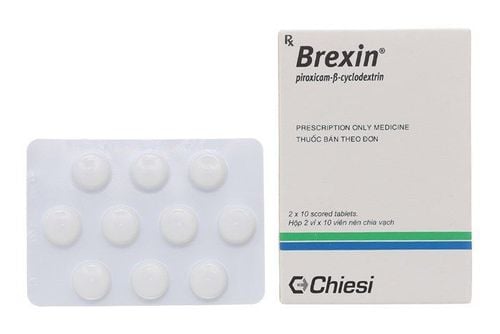This is an automatically translated article.
The drug Zalenka has the main ingredient Minocycline is often used to treat infections such as acne, skin infections, soft tissue infections, eyes, ears, nose and throat... So what is Zalenka?1. What is Zalenka?
The ingredients in each Zalenka hard capsule contain Minocycline hydrochloride equivalent to Minocycline 50 mg and a system of excipients: Calcium phosphate dibasic anhydrous, talc, magnesium stearate, croscarmellose sodium, silicon dioxide.Minocycline is an antibiotic with a spectrum of action and mechanism of action similar to tetracycline but active against many bacterial strains including Staphylococcus aureus, Streptococcus strains, Neisseria meningitidis, Acinetobacter, Bacteroides, Haemophilus, Nocardia, enteric bacilli. , several types of Mycobacteria including M.leprae. Mechanism of action Zalenka is like tetracycline: Binds to the 30S ribosomal site and inhibits bacterial ribosome function, inhibits bacterial protein synthesis by blocking aminoacyl tRNA binding.
2. What does Zalenka do?
Minocycline in Zalenka is a broad-spectrum antibiotic active ingredient, used orally to treat infections caused by strains of bacteria that are still susceptible to tetracycline antibiotics and some strains of Staphylococci that are resistant to tetracyclines.
Indications of the drug Zalenka include:
Acne ; Skin and soft tissue infections; Eye infections; Acute and chronic bronchitis; Bronchiectasis; Lung abscess ; Ear, nose and throat infections; Pelvic infection; Urinary infection; Gonorrhea; Urethritis ; Prostatitis not caused by gonorrhea. In addition, Zalenka is also indicated for the treatment of:
Syphilis: Minocycline is antibiotic therapy for the replacement of penicillin in adults, children > 12 years old, non-pregnant women who are allergic to penicillin. penicillin; Mycobacterial bacilli: Leprosy in adults who cannot use rifampicin due to allergies or infections with rifampicin-resistant bacteria, clofazimin intolerance and leprosy in children with monogenic leprosy ; Zalenka for the treatment of skin infections caused by M. marinum; Cholera; Zalenka treats infections caused by bacteria of the family Nocardia; Rheumatoid arthritis ; Minocycline can be used for prophylaxis in asymptomatic carriers of Neisseria meningitidis; Use Zalenka before and after surgery to prevent infection.
3. Dosage of the drug Zalenka
Taking Zalenka with plenty of water in a standing or sitting position helps to reduce the risk of irritation or ulceration of the esophagus. Zalenka can be taken with or without meals. Absorption of Zalenka capsules is not significantly affected by food or moderate milk intake. Zalenka tablets should be swallowed whole, do not chew, bite or break the tablet. Antacids, calcium and iron supplements, magnesium-containing laxatives and cholestyramine must be taken within 2 hours of taking Minocycline-containing drugs. Zalenka Dosage:
3.1. Adult dose Zalenka treats infections with an initial dose of 200 mg, then 100 mg every 12 hours, or may be divided into an initial dose of 100 - 200 mg, then 50 mg 4 times a day.
Zalenka dose used to treat some specific cases:
Zalenka acne treatment: 50mg x 2 times / day or 100mg x 1 time / day for at least 6 weeks; Chlamydia infection or Ureaplasma urealyticum: 100mg every 12 hours, take Zalenka for at least 7 days; Uncomplicated gonococcal infection: Initial dose of Zalenka 200mg, then 100mg every 12 hours for at least 5 days; Gonococcal urethritis: Zalenka dose is 100 mg every 12 hours for 5 days; Asymptomatic Neisseria meningitidis infection: Zalenka 100mg every 12 hours for 5 days, then continue treatment with antibiotic rifampicin; Infections caused by bacteria of the Nocardia family: The usual dose of Minocycline in combination with Sulfamides is for 12-18 months. If after 6 months Zalenka does not give the desired response, minocycline should be discontinued and other therapies considered. If minocycline is continued for more than 6 months, patients should be monitored at least every 3 months for signs and symptoms of hepatitis/systemic lupus erythematosus; Rheumatoid arthritis: use Zalenka 100mg every 12 hours for 1-3 months; Zalenka treatment for syphilis: 100mg every 12 hours for 10-15 days; Cholera: The initial dose of Zalenka is 200mg, then 100mg every 12 hours for 48 - 72 hours; Leprosy: Bacterial leprosy cannot be treated with rifampicin, switch to Minocycline 100 mg/day in combination with other leprosy drugs (clofazimin 50mg/day, ofloxacin 400mg/day) in 6 months of attack, continue by 18 months maintained with minocycline 100 mg/day and clofazimin 50 mg/day; For bacterial leprosy that cannot be treated with clofazimin, Minocycline 100mg/time/month, combined with ofloxacin 400mg/time/month and rifampicin 600mg/time/month for 24 months; Single-lesion leprosy use a single dose of rifampicin 60mg, ofloxacin 400mg and minocycline 100mg. 3.2. Zalenka dose for special populations Children 12 years of age and older: Initial dose of Zalenka 100mg, then 50mg every 12 hours; Children under 12 years: The use of Zalenka is not recommended; Elderly: Zalenka can be used at the usual recommended dose; Renal Impairment: Use the usual recommended dose of Zalenka for patients with mild and moderate renal impairment, caution when using Zalenka in patients with severe renal impairment.
4. Contraindications of Zalenka
Contraindications to using Zalenka for the following cases:
Hypersensitivity to minocycline, tetracycline or any component of the drug Zalenka; Systemic lupus erythematosus ; Complete renal failure; Children under 12 years old; Pregnant and lactating women.
5. Notes when using Zalenka
5.1. Shortness of breath with Zalenka Respiratory difficulties including dyspnea, bronchospasm, worsening asthma, pulmonary eosinophilia, and pneumonia have been reported with Minocycline use. Therefore, if the patient has difficulty breathing, they should stop taking minocycline and immediately notify the treating doctor;
5.2. The effect of Zalenka on tooth development Minocycline is similar to tetracycline antibiotics which can harm the fetus when administered to pregnant women, if taking any tetracycline drug during pregnancy should be informed about the potential risk to the fetus, in addition the use of tetracyclines during the period of tooth development (second half of pregnancy, infants and children under 8 years of age) can cause tooth discoloration permanent, this effect is more common with prolonged use of Zalenka but has also been reported with repeated short-term courses. In addition, enamel hypoplasia has also been reported, so tetracyclines should not be used during tooth development;
5.3. Zalenka Affects Bone Growth All tetracyclines form stable calcium complexes in any bone-formed tissue, thereby reducing the rate of fibula growth. This has been reported in premature infants receiving tetracycline 25 mg/kg every 6 hours and was reversible upon discontinuation of the drug.
5.4. Use of Zalenka in Pregnancy Results from animal studies suggest that tetracyclines can cross the placenta and may be toxic to the developing fetus (associated with skeletal retardation). . Evidence of embryotoxicity has been reported in animals treated with this drug during early pregnancy.
5.5. Skin reactions with Zalenka Cases of drug rash with eosinophilia and systemic symptoms (DRESS), including death, have been reported with minocycline.
5.6. Zalenka and catabolic activity The catabolic activity of tetracycline antibiotics can increase blood urea nitrogen (BUN). This is not a problem in individuals with normal renal function, however in individuals with significant renal impairment, high serum tetracycline concentrations may lead to uremia, hyperphosphatemia and acidosis. Therefore, it is recommended to monitor creatinine and BUN, and the total daily dose should not exceed 200 mg/24 hours.
5.7. Photosensitivity with Zalenka Photosensitivity manifested by an exaggerated sunburn reaction has been reported with minocycline.
5.8. Zalenka and Central Nervous System Adverse effects of Zalenka on the central nervous system including: delirium, dizziness or lightheadedness have been reported during treatment with minocycline antibiotics and usually disappear rapidly upon discontinuation of the drug. , so caution should be exercised when driving or operating machinery. CNS adverse reactions associated with minocycline have a higher frequency than with other tetracycline antibiotics, particularly vestibular disorders in 21-90% of patients treated with conventional minocycline doses. often.
5.9. Clostridium difficile-associated diarrhea with Zalenka Clostridium difficile-associated diarrhea has been reported with most antibacterial agents including minocycline, the severity of which can vary from mild diarrhea to fatal colitis.
5.10. Drug-associated ICP Increased intracranial pressure has been associated with the use of tetracyclines, including minocycline, with manifestations including: headache, visual impairment, blurred vision, diplopia. Papilledema can be found on endoscopy. Concomitant use of isotretinoin and minocycline should be avoided because isotretinoin may cause pseudotumor brain. Although raised intracranial pressure may resolve on its own after discontinuation of treatment, it has the potential to cause permanent vision loss.
5.11. Myasthenia The tetracyclines can cause neuromuscular weakness, caution in people with myasthenia gravis.
5.12. Hyperpigmentation Similar to other tetracyclines, minocycline can cause hyperpigmentation at different sites in the body regardless of dose or duration of treatment.
5.13. Autoimmune disorders Autoimmune hepatotoxicity and systemic lupus erythematosus or exacerbation of systemic lupus erythematosus have been reported in patients receiving minocycline, where minocycline should be discontinued.
5.14. Hepatic impairment Use caution when using Zalenka in patients with liver dysfunction, taking Zalenka with alcohol or other hepatotoxic drugs.
5.15. Renal impairment Studies have shown no significant accumulation of minocycline in patients with mild to moderate renal impairment at the recommended dose. In cases of severe renal impairment, it may be necessary to reduce the dose of Zalenka and monitor renal function.
6. Zalenka side effects
Common Zalenka side effects: Dizziness. Uncommon side effects of Zalenka: Fever. Rare Zalenka side effects: Eosinophils, leukopenia, neutropenia, thrombocytopenia, hypersensitivity/anaphylactic reactions (including shock and death), anorexia, headache, .... Side effects of Zalenka are very rare: Candida infections of the mouth and genitals, vulvovaginitis and vulvovaginitis, hemolytic anemia, pancytopenia,... Side effects of Zalenka Frequency not known: Agranulocytosis, hypersensitivity, pulmonary infiltrates, allergic purpura, drug rash with eosinophilia and systemic symptoms (DRESS).
7. Interactions of Zalenka with other drugs
Anticoagulants: The minocycline in Zalenka may inhibit the activity of plasma prothrombin, the dose of anticoagulants should be reduced in patients receiving minocycline. ACE inhibitors, antacids and adsorbents: Tetracyclines bind to divalent or trivalent cations, the absorption of Zalenka from the gastrointestinal tract is reduced when used concomitantly with salts of iron, calcium, aluminum, magnesium, bismuth and zinc (drugs containing mineral salts, antacids, kaolin, stomach ulcers containing bismuth) so the time to use Zalenka and these drugs should be far apart; Diuretics: may exacerbate nephrotoxicity due to volume depletion when used with Zalenka; Other antibiotics: the bacteriostatic effect of Zalenka reduces the bactericidal effect of penicillin, the combination of these 2 drugs should be avoided; Ergotamine and ergometrin: Zalenka increases the risk of ergotin toxicity; Oral contraceptives: minocycline found in Zalenka and oral contraceptives both increase pigmentation; Retinoids: avoid isotretinoin before, during and immediately after treatment with Zalenka because of the risk of increased intracranial pressure; Laboratory tests: Zalenka may interfere with the urine urobilinogen test by reducing the bacteria that convert bilirubin to urobilinogen and Zalenka affects the fluorescence measurement in the Hungarian method for the quantification of urinary catecholamines.
Please dial HOTLINE for more information or register for an appointment HERE. Download MyVinmec app to make appointments faster and to manage your bookings easily.













